
cml
专注MLOps的开源持续集成工具
CML是一款专注MLOps的开源命令行工具,用于机器学习项目的持续集成和交付。它能自动化配置环境、训练评估模型、比较实验结果和监控数据变化。CML可在每次代码提交时自动执行工作流程,生成可视化报告。该工具采用GitFlow工作模式,无需额外服务即可搭建完整的机器学习平台。
What is CML? Continuous Machine Learning (CML) is an open-source CLI tool for implementing continuous integration & delivery (CI/CD) with a focus on MLOps. Use it to automate development workflows — including machine provisioning, model training and evaluation, comparing ML experiments across project history, and monitoring changing datasets.
CML can help train and evaluate models — and then generate a visual report with results and metrics — automatically on every pull request.
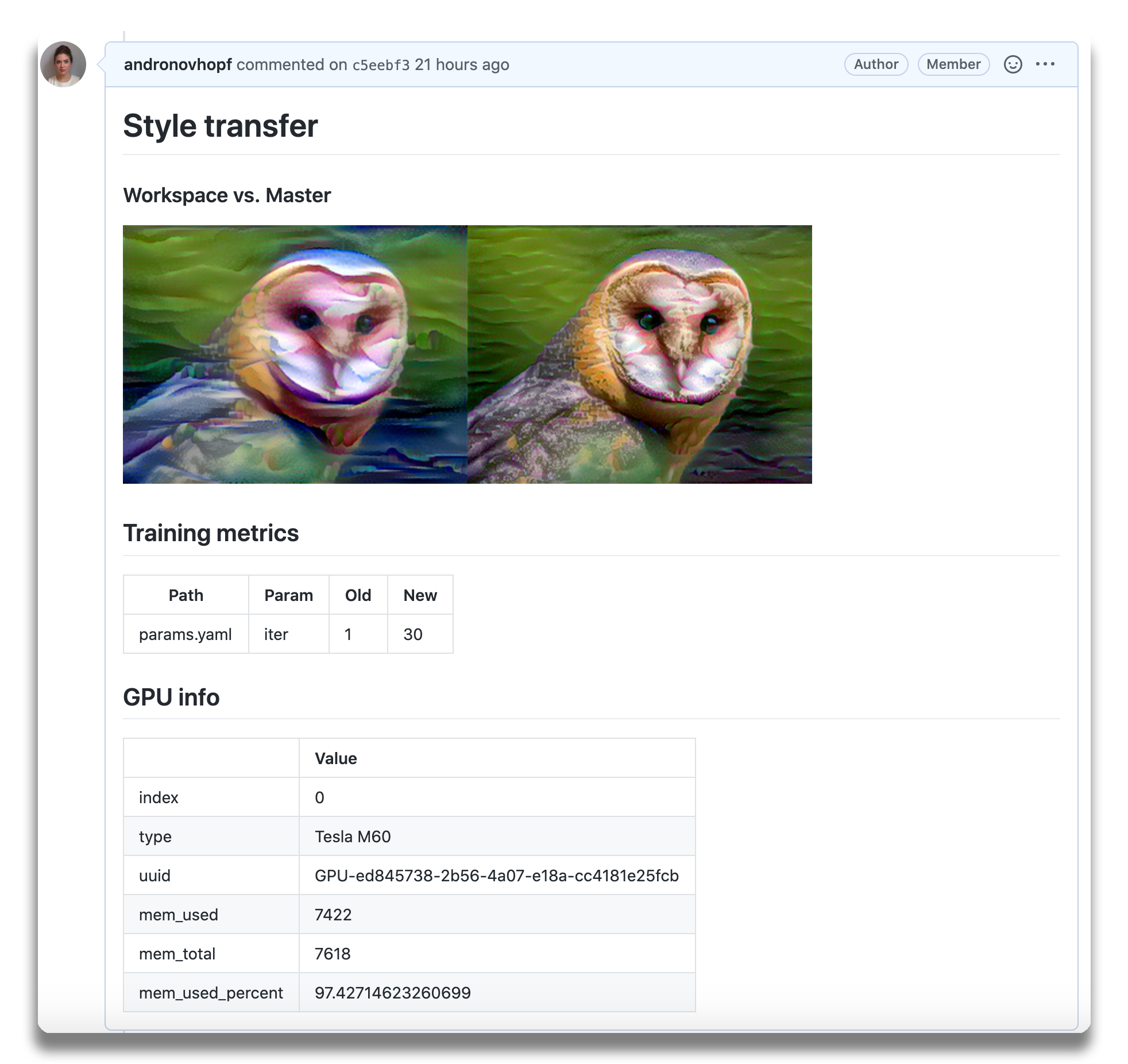 An
example report for a
neural style transfer model.
An
example report for a
neural style transfer model.
CML principles:
- GitFlow for data science. Use GitLab or GitHub to manage ML experiments, track who trained ML models or modified data and when. Codify data and models with DVC instead of pushing to a Git repo.
- Auto reports for ML experiments. Auto-generate reports with metrics and plots in each Git pull request. Rigorous engineering practices help your team make informed, data-driven decisions.
- No additional services. Build your own ML platform using GitLab, Bitbucket, or GitHub. Optionally, use cloud storage as well as either self-hosted or cloud runners (such as AWS EC2 or Azure). No databases, services or complex setup needed.
:question: Need help? Just want to chat about continuous integration for ML? Visit our Discord channel!
:play_or_pause_button: Check out our YouTube video series for hands-on MLOps tutorials using CML!
Table of Contents
- Setup (GitLab, GitHub, Bitbucket)
- Usage
- Getting started (tutorial)
- Using CML with DVC
- Advanced Setup (Self-hosted, local package)
- Example projects
Setup
You'll need a GitLab, GitHub, or Bitbucket account to begin. Users may wish to familiarize themselves with Github Actions or GitLab CI/CD. Here, will discuss the GitHub use case.
GitLab
Please see our docs on CML with GitLab CI/CD and in particular the personal access token requirement.
Bitbucket
Please see our docs on CML with Bitbucket Cloud.
GitHub
The key file in any CML project is .github/workflows/cml.yaml:
name: your-workflow-name on: [push] jobs: run: runs-on: ubuntu-latest # optionally use a convenient Ubuntu LTS + DVC + CML image # container: ghcr.io/iterative/cml:0-dvc2-base1 steps: - uses: actions/checkout@v3 # may need to setup NodeJS & Python3 on e.g. self-hosted # - uses: actions/setup-node@v3 # with: # node-version: '16' # - uses: actions/setup-python@v4 # with: # python-version: '3.x' - uses: iterative/setup-cml@v1 - name: Train model run: | # Your ML workflow goes here pip install -r requirements.txt python train.py - name: Write CML report env: REPO_TOKEN: ${{ secrets.GITHUB_TOKEN }} run: | # Post reports as comments in GitHub PRs cat results.txt >> report.md cml comment create report.md
Usage
We helpfully provide CML and other useful libraries pre-installed on our
custom Docker images.
In the above example, uncommenting the field
container: ghcr.io/iterative/cml:0-dvc2-base1) will make the runner pull the
CML Docker image. The image already has NodeJS, Python 3, DVC and CML set up on
an Ubuntu LTS base for convenience.
CML Functions
CML provides a number of functions to help package the outputs of ML workflows (including numeric data and visualizations about model performance) into a CML report.
Below is a table of CML functions for writing markdown reports and delivering those reports to your CI system.
| Function | Description | Example Inputs |
|---|---|---|
cml runner launch | Launch a runner locally or hosted by a cloud provider | See Arguments |
cml comment create | Return CML report as a comment in your GitLab/GitHub workflow | <path to report> --head-sha <sha> |
cml check create | Return CML report as a check in GitHub | <path to report> --head-sha <sha> |
cml pr create | Commit the given files to a new branch and create a pull request | <path>... |
cml tensorboard connect | Return a link to a Tensorboard.dev page | --logdir <path to logs> --title <experiment title> --md |
CML Reports
The cml comment create command can be used to post reports. CML reports are
written in markdown (GitHub,
GitLab, or
Bitbucket
flavors). That means they can contain images, tables, formatted text, HTML
blocks, code snippets and more — really, what you put in a CML report is up to
you. Some examples:
:spiral_notepad: Text Write to your report using whatever method you prefer. For example, copy the contents of a text file containing the results of ML model training:
cat results.txt >> report.md
:framed_picture: Images Display images using the markdown or HTML. Note that
if an image is an output of your ML workflow (i.e., it is produced by your
workflow), it can be uploaded and included automaticlly to your CML report. For
example, if graph.png is output by python train.py, run:
echo "" >> report.md cml comment create report.md
Getting Started
- Fork our example project repository.
:warning: Note that if you are using GitLab, you will need to create a Personal Access Token for this example to work.
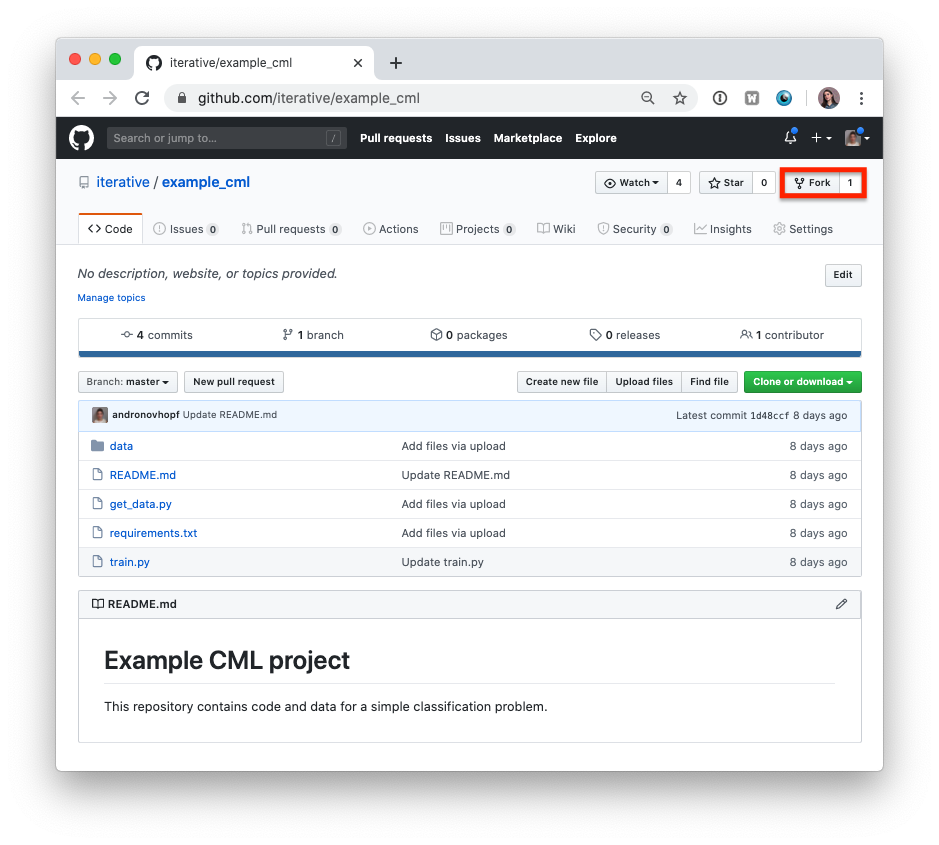
:warning: The following steps can all be done in the GitHub browser interface. However, to follow along with the commands, we recommend cloning your fork to your local workstation:
git clone https://github.com/<your-username>/example_cml
- To create a CML workflow, copy the following into a new file,
.github/workflows/cml.yaml:
name: model-training on: [push] jobs: run: runs-on: ubuntu-latest steps: - uses: actions/checkout@v3 - uses: actions/setup-python@v4 - uses: iterative/setup-cml@v1 - name: Train model env: REPO_TOKEN: ${{ secrets.GITHUB_TOKEN }} run: | pip install -r requirements.txt python train.py cat metrics.txt >> report.md echo "" >> report.md cml comment create report.md
-
In your text editor of choice, edit line 16 of
train.pytodepth = 5. -
Commit and push the changes:
git checkout -b experiment git add . && git commit -m "modify forest depth" git push origin experiment
- In GitHub, open up a pull request to compare the
experimentbranch tomain.
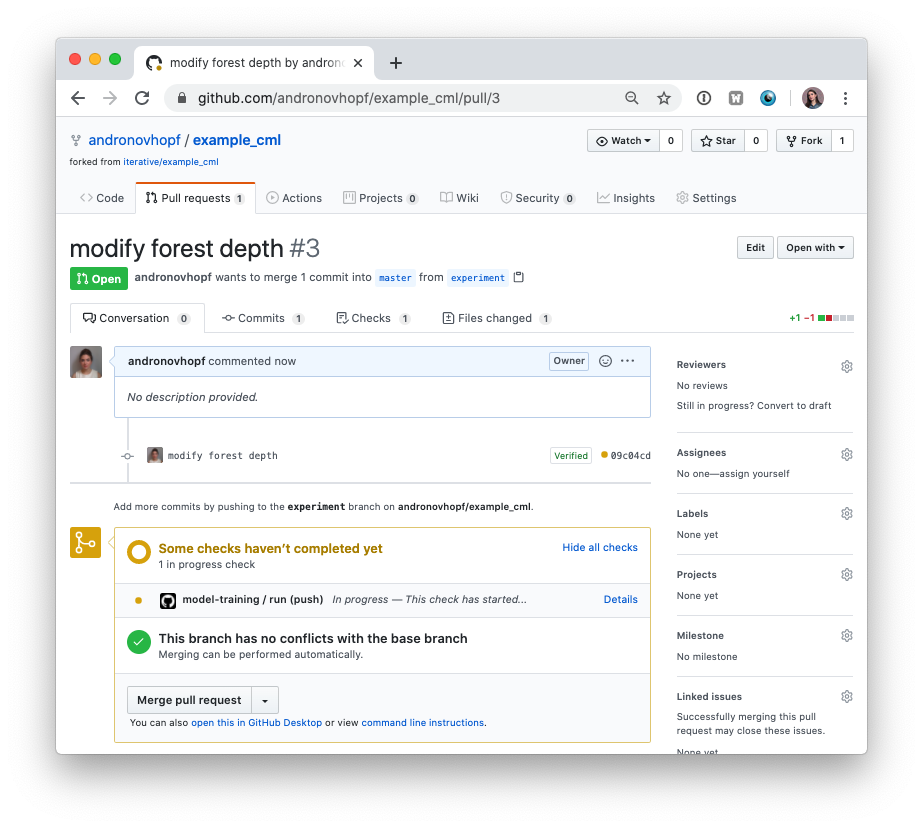
Shortly, you should see a comment from github-actions appear in the pull
request with your CML report. This is a result of the cml send-comment
function in your workflow.
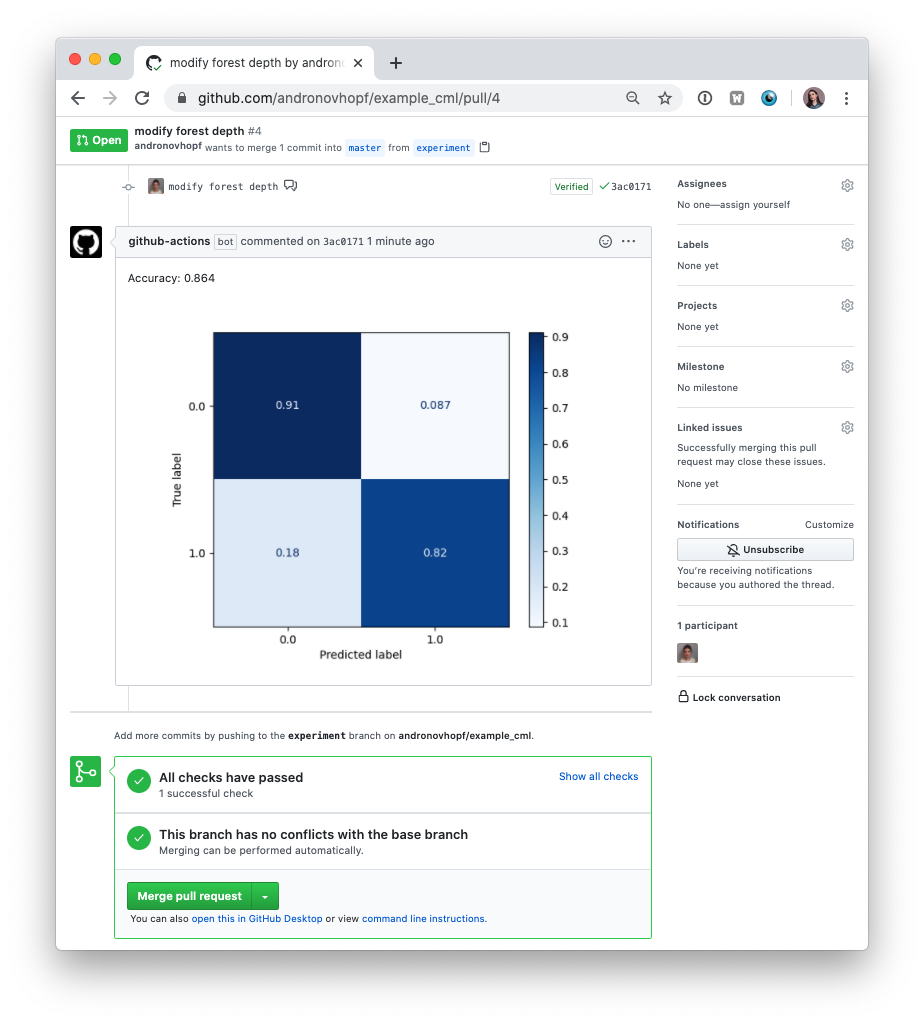
This is the outline of the CML workflow:
- you push changes to your GitHub repository,
- the workflow in your
.github/workflows/cml.yamlfile gets run, and - a report is generated and posted to GitHub.
CML functions let you display relevant results from the workflow — such as model performance metrics and visualizations — in GitHub checks and comments. What kind of workflow you want to run, and want to put in your CML report, is up to you.
Using CML with DVC
In many ML projects, data isn't stored in a Git repository, but needs to be downloaded from external sources. DVC is a common way to bring data to your CML runner. DVC also lets you visualize how metrics differ between commits to make reports like this:
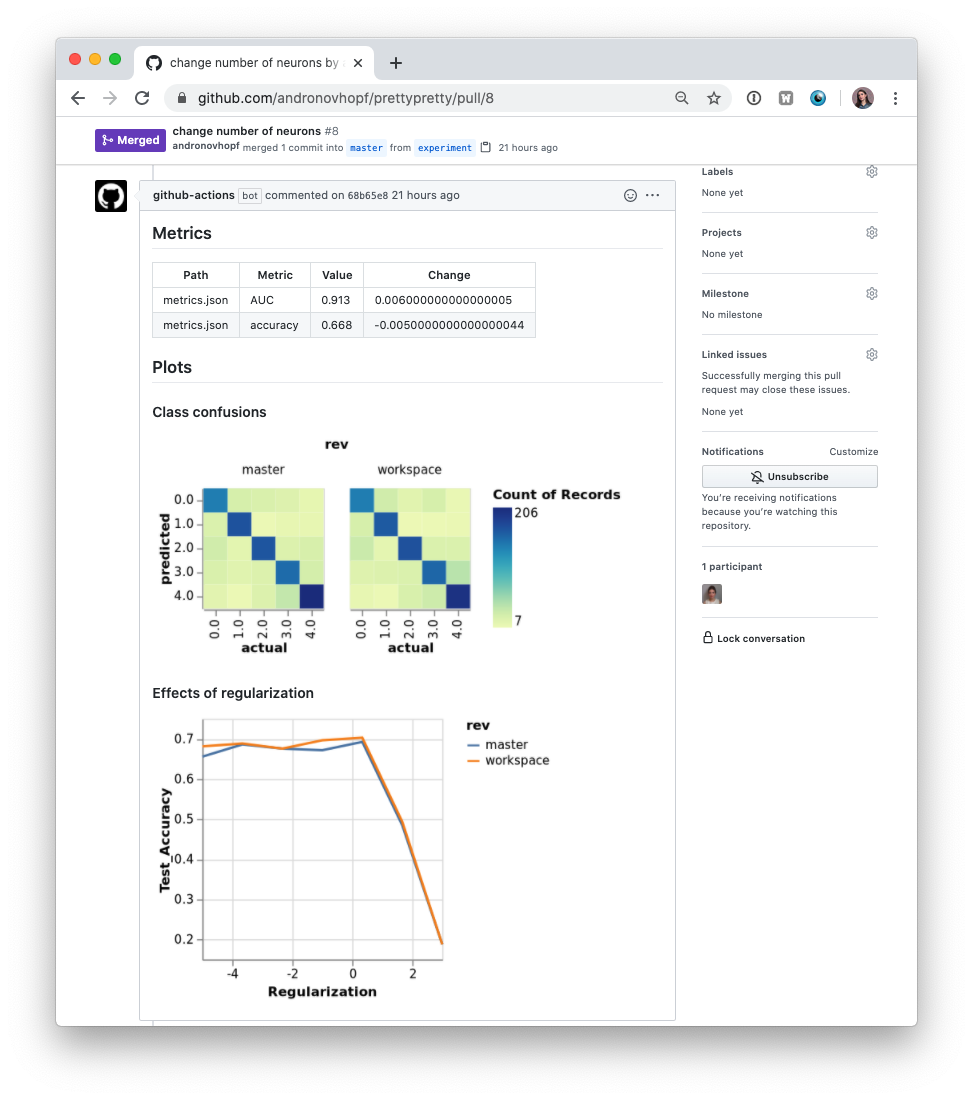
The .github/workflows/cml.yaml file used to create this report is:
name: model-training on: [push] jobs: run: runs-on: ubuntu-latest container: ghcr.io/iterative/cml:0-dvc2-base1 steps: - uses: actions/checkout@v3 - name: Train model env: REPO_TOKEN: ${{ secrets.GITHUB_TOKEN }} AWS_ACCESS_KEY_ID: ${{ secrets.AWS_ACCESS_KEY_ID }} AWS_SECRET_ACCESS_KEY: ${{ secrets.AWS_SECRET_ACCESS_KEY }} run: | # Install requirements pip install -r requirements.txt # Pull data & run-cache from S3 and reproduce pipeline dvc pull data --run-cache dvc repro # Report metrics echo "## Metrics" >> report.md git fetch --prune dvc metrics diff main --show-md >> report.md # Publish confusion matrix diff echo "## Plots" >> report.md echo "### Class confusions" >> report.md dvc plots diff --target classes.csv --template confusion -x actual -y predicted --show-vega main > vega.json vl2png vega.json -s 1.5 > confusion_plot.png echo "" >> report.md # Publish regularization function diff echo "### Effects of regularization" >> report.md dvc plots diff --target estimators.csv -x Regularization --show-vega main > vega.json vl2png vega.json -s 1.5 > plot.png echo "" >> report.md cml comment create report.md
:warning: If you're using DVC with cloud storage, take note of environment variables for your storage format.
Configuring Cloud Storage Providers
There are many supported could storage providers. Here are a few examples for some of the most frequently used providers:
<details> <summary> S3 and S3-compatible storage (Minio, DigitalOcean Spaces, IBM Cloud Object Storage...) </summary># Github env: AWS_ACCESS_KEY_ID: ${{ secrets.AWS_ACCESS_KEY_ID }} AWS_SECRET_ACCESS_KEY: ${{ secrets.AWS_SECRET_ACCESS_KEY }} AWS_SESSION_TOKEN: ${{ secrets.AWS_SESSION_TOKEN }}
:point_right:
AWS_SESSION_TOKENis optional.
</details> <details> <summary> Azure </summary>:point_right:
AWS_ACCESS_KEY_IDandAWS_SECRET_ACCESS_KEYcan also be used bycml runnerto launch EC2 instances. See [Environment Variables].
</details> <details> <summary> Aliyun </summary>env: AZURE_STORAGE_CONNECTION_STRING: ${{ secrets.AZURE_STORAGE_CONNECTION_STRING }} AZURE_STORAGE_CONTAINER_NAME: ${{ secrets.AZURE_STORAGE_CONTAINER_NAME }}
</details> <details> <summary> Google Storage </summary>env: OSS_BUCKET: ${{ secrets.OSS_BUCKET }} OSS_ACCESS_KEY_ID: ${{ secrets.OSS_ACCESS_KEY_ID }} OSS_ACCESS_KEY_SECRET: ${{ secrets.OSS_ACCESS_KEY_SECRET }} OSS_ENDPOINT: ${{ secrets.OSS_ENDPOINT }}
:warning: Normally,
GOOGLE_APPLICATION_CREDENTIALSis the path of thejsonfile containing the credentials. However in the action this secret variable is the contents of the file. Copy thejsoncontents and add it as a secret.
</details> <details> <summary> Google Drive </summary>env: GOOGLE_APPLICATION_CREDENTIALS: ${{ secrets.GOOGLE_APPLICATION_CREDENTIALS }}
:warning: After configuring your Google Drive credentials you will find a
jsonfile atyour_project_path/.dvc/tmp/gdrive-user-credentials.json. Copy its contents and add it as a secret variable.
</details>env: GDRIVE_CREDENTIALS_DATA: ${{ secrets.GDRIVE_CREDENTIALS_DATA }}
Advanced Setup
Self-hosted (On-premise or Cloud) Runners
GitHub Actions are run on GitHub-hosted runners by default. However, there are many great reasons to use your own runners: to take advantage of GPUs, orchestrate your team's shared computing resources, or train in the cloud.
:point_up: Tip! Check out the official GitHub documentation to get started setting up your own self-hosted runner.
Allocating Cloud Compute Resources with CML
When a workflow requires computational resources (such as GPUs), CML can
automatically allocate cloud instances using cml runner. You can spin up
instances on AWS, Azure, GCP, or Kubernetes.
For example, the following workflow deploys a g4dn.xlarge instance on AWS EC2
and trains a model on the instance. After the job runs, the instance
automatically shuts down.
You might notice that this workflow is quite similar to the
basic use case above. The only addition is cml runner and a few
environment variables for passing your cloud service credentials to the
workflow.
Note that cml runner will also automatically restart your jobs (whether from a
GitHub Actions 35-day workflow timeout
or a
AWS EC2 spot instance interruption).
name: Train-in-the-cloud on: [push] jobs: deploy-runner: runs-on: ubuntu-latest steps: - uses: iterative/setup-cml@v1 - uses: actions/checkout@v3 - name: Deploy runner on EC2 env: REPO_TOKEN: ${{ secrets.PERSONAL_ACCESS_TOKEN }} AWS_ACCESS_KEY_ID: ${{ secrets.AWS_ACCESS_KEY_ID }} AWS_SECRET_ACCESS_KEY: ${{ secrets.AWS_SECRET_ACCESS_KEY }} run: | cml runner launch \ --cloud=aws \ --cloud-region=us-west \ --cloud-type=g4dn.xlarge \ --labels=cml-gpu train-model: needs: deploy-runner runs-on: [self-hosted, cml-gpu] timeout-minutes: 50400 # 35 days container: image: ghcr.io/iterative/cml:0-dvc2-base1-gpu options: --gpus all steps: - uses: actions/checkout@v3 - name: Train model env: REPO_TOKEN: ${{ secrets.PERSONAL_ACCESS_TOKEN }} run: | pip install -r requirements.txt python train.py cat metrics.txt > report.md cml comment create report.md
In the workflow above, the deploy-runner step launches an EC2
编辑推荐精选


Refly.AI
最适合小白的AI自动化工作流平台
无需编码,轻松生成可复用、可变现的AI自动化工作流


酷表ChatExcel
大模型驱动的Excel数据处理工具
基于大模型交互的表格处理系统,允许用户通过对话方式完成�数据整理和可视化分析。系统采用机器学习算法解析用户指令,自动执行排序、公式计算和数据透视等操作,支持多种文件格式导入导出。数据处理响应速度保持在0.8秒以内,支持超过100万行数据的即时分析。


TRAE编程
AI辅助编程,代码自动修复
Trae是一种自适应的集成开发环境(IDE),通过自动化和多元协作改变开发流程。利用Trae,团队能够更快速、精确地编写和部署代码,从而提高编程效率和项目交付速度。Trae具备上下文感知和代码自动完成功能,是提升开发效率的理想工具。


AIWritePaper论文写作
AI论文写作指导平台
AIWritePaper论文写作是一站式AI论文写作辅助工具,简化了选题、文献检索至论文撰写的整个过程。通过简单设定,平台可快速生成高质量论文大纲和全文,配合图表、参考文献等一应俱全,同时提供开题报告和答辩PPT等增值服务,保障数据安全,有效提升写作效率和论文质量。


博思AIPPT
AI一键生成PPT,就用博思AIPPT!
博思AIPPT,新一代的AI生成PPT平台,支持智能生成PPT、AI美化PPT、文本&链接生成PPT、导入Word/PDF/Markdown文档生成PPT等,内置海量精美PPT模板,涵盖商务、教育、科技等不同风格,同时针对每个页面提供多种版式,一键自适应切换,完美适配各种办公场景。


潮际好麦
AI赋能电商视觉革命,一站式智能商拍平台
潮际好麦深耕服装行业,是国内AI试衣效果最好的软件。使用先进AIGC能力为电商卖家批量提供优质的、低成本的商拍图。合作品牌有Shein、Lazada、安踏、百丽等65个国内外头部品牌,以及国内10万+淘宝、天猫、京东等主流平台的品牌商家,为卖家节省将近85%的出图成本,提升约3倍出图效率,让品牌能够快速上架。


iTerms
企业专属的AI法律顾问
iTerms是法大大集团旗下法律子品牌,基于最先进的大语言模型(LLM)、专业的法律知识库和强大的智能体架构,帮助企业扫清合规障碍,筑牢风控防线,成为您企业专属的AI法律顾问。


SimilarWeb流量提升
稳定高效的流量提��升解决方案,助力品牌曝光
稳定高效的流量提升解决方案,助力品牌曝光


Sora2视频免费生成
最新版Sora2模型免费使用,一键生成无水印视频
最新版Sora2模型免费使用,一键生成无水印视频


Transly
实时语音翻译/同声传译工具
Transly是一个多场景的AI大语言模型驱动的同声传译、专业翻译助手,它拥有超精准的音频识别翻译能力,几乎零延迟的使用体验和支持多国语言可以让你带它走遍全球,无论你是留学生、商务人士、韩剧美剧爱好者,还是出国游玩、多国会议、跨国追星等等,都可以满足你所有需要同传的场景需求,线上线下通用,扫除语言障碍,让全世界的语言交流不再有国界。
推荐工具精选
AI云服务特惠
懂AI专属折扣关注微信公众号
最新AI工具、AI资讯
独家AI资源、AI项目落地

微信扫一扫关注公众号







